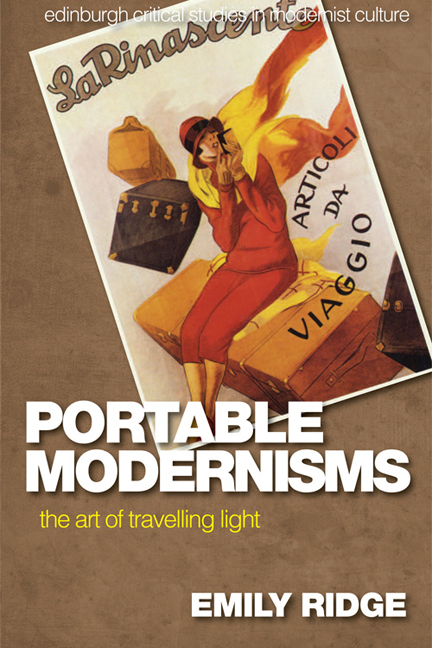Book contents
- Frontmatter
- Contents
- Illustrations
- Acknowledgements
- Series Editors’ Preface
- Dedication
- Introduction
- 1 ‘Living modernly's living quickly’: Towards Travelling Light
- 2 ‘A purse of her own’: Women and Carriage
- 3 ‘No one is safe from the beggar's pack’: Portability and Precarity
- 4 ‘Have you anything to declare?’: Portable Selves on Trial
- Conclusion
- Bibliography
- Index
1 - ‘Living modernly's living quickly’: Towards Travelling Light
Published online by Cambridge University Press: 22 December 2017
- Frontmatter
- Contents
- Illustrations
- Acknowledgements
- Series Editors’ Preface
- Dedication
- Introduction
- 1 ‘Living modernly's living quickly’: Towards Travelling Light
- 2 ‘A purse of her own’: Women and Carriage
- 3 ‘No one is safe from the beggar's pack’: Portability and Precarity
- 4 ‘Have you anything to declare?’: Portable Selves on Trial
- Conclusion
- Bibliography
- Index
Summary
In a 1901 review of a new edition and translation of the Arabian Nights, G. K. Chesterton praises its ‘bulk, bigness, magnitude’ against anticipated charges of the inconvenience of its voluminous size: ‘The “Arabian Nights” is a collection of extraordinarily good stories, and while the modern aesthetic critic will probably find the book too long, the person with a taste for literature will find it too short.’ In defending monumentality and scale in literature – what he sees as an ‘element of value in architecture’, among other forms and media – Chesterton draws attention to an emerging literary preference for brevity or succinctness. Such a preference seems to suggest a ‘modern aesthetic’ move away from the bulkier forms of the previous century, and it is a trend he subjects to question: ‘It is considered one of the elemental merits of a book that it should be “portable”. But why?’ Chesterton's interrogation of this development is less interesting than the fact of his observation. Though his outward emphasis is on the size of the book in a physical sense, his criticism is more nuanced than this. In setting himself against those ‘modern aesthetic critics’, he uses the idea of portability to highlight a perceptible value shift in literary appreciation – and, by implication, literary production – which is as much conceptual as physical.
Chesterton hits on a critical transition here. He intuits that stable and stabilising forms, motifs and metaphors, establishing the kind of monumental quality he endorses, are beginning to lack relevance in an age of flux. Instead, a new portable ethos is coming to shape artistic vision and even the nuts and bolts of stylistic technique, anticipating the 1916 observation of Georg Lukács that the ‘ultimate basis for artistic creation has become homeless’. Chesterton's remarks can equally be found to reflect a growing thematic preoccupation with portability to the extent that literary narratives come to revolve less around domestic inheritance than departure and, accordingly, less around the symbolic form of the house than the case. While architectural forms, motifs and metaphors have received extensive literary critical attention, from Ellen Eve Frank's Literary Architecture (1979) through to David Spurr's more recent Architecture and Modern Literature (2012), this emphatic turn towards a portable paradigm from the late nineteenth century has largely been overlooked to date.
- Type
- Chapter
- Information
- Portable ModernismsThe Art of Travelling Light, pp. 31 - 65Publisher: Edinburgh University PressPrint publication year: 2017

